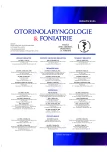-
Medical journals
- Career
Current classification and staging of middle ear cholesteatoma
Authors: T. Valenta 1; Michal Homoláč 1; L. Školoudík 1,2; Jan Mejzlík 1,2; Viktor Chrobok 1,2
Authors‘ workplace: Klinika otorinolaryngologie a chirurgie hlavy a krku, Fakultní nemocnice Hradec Králové 1; Univerzita Karlova, Lékařská fakulta v Hradci Králové 2
Published in: Otorinolaryngol Foniatr, 69, 2020, No. 4, pp. 172-176.
Category: Original Article
Overview
Introduction: In 2017, the European Academy of Otology and Neurotology and the Japanese Otological Society published Joint Consensus Statements on the Definitions, Classification and Staging of Middle Ear Cholesteatoma. The aim of this work is an application of the new classification system at the Department of Otorhinolaryngology and Head and Neck Surgery of the University Hospital Hradec Králové.
Material and Methods: Authors retrospectively revised a group of patients who underwent surgery for chronic otitis media with cholesteatoma in years 2013–2017. A total of 104 patients, 56 males and 48 females, were enrolled in the study.
Results: A total of 142 surgeries (77 primary, 65 secondary) revealed 116 cholesteatomas of which 3 remained unclassifiable. A congenital cholesteatoma was found in 4 patients, an acquired cholesteatoma was found in 70 cases (60.3%). The most common type was retraction pocket cholesteatoma (60 surgeries, 51.7%), with predominance of pars flaccida cholesteatomas. Acquired non-retraction pocket cholesteatomas were less common (10 surgeries, 8.6%), where secondary to tympanic membrane cholesteatomas predominated (6 surgeries, 5.2%). Of the 65 secondary surgeries, 39 cholesteatomas were found (33.6%), residual cholesteatomas were found in 20 patients (17.2%), and recurrent cholesteatomas were found in 19 patients (16.4%). Stage I cholesteatoma was found in 42 (36.2%) patients, stage II cholesteatoma in 60 (51.7%) patients, stage III cholesteatoma in 13 (11.2%) patients and stage IV cholesteatoma in a single patient (1.0%). Authors further examine incidence of cholesteatoma types in comparison with STAM sites.
Conclusion: New cholesteatoma classification systems have potential to build unified database of patients with chronic suppurative otitis media with cholesteatoma. It will be certainly a benefit to continue to prospectively expand the database.
Keywords:
classification – congenital cholesteatoma – staging – cholesteatoma – acquired cholesteatoma – definition – EAONO/JOS – STAM
Sources
1. Akarcay, M., Kalcioglu, M. T., Tuysuz, O., et al.: Ossicular chain erosion in chronic otitis media patients with cholesteatoma or granulation tissue or without those: analysis of 915 cases. Eur Arch Otorhinolaryngol, 276, 2019, 5, s. 1301–1305.
2. Bakaj, T., Zbrožková Bakaj, L., Salzman, R., et al.: Role zobrazovacích metod v diagnostickém a terapeutickém postupu u cholesteatomu spánkové kosti. Otorinolaryngol Foniatr, 65, 2016, 3, s. 173–178.
3. Garrido, L., Cenjor, C., Montoya, J., et al.: Diagnostic capacity of non-echo planar diffusion-weighted MRI in the detection of primary and recurrent cholesteatoma. Acta Otorrinolaringol Esp, 66, 2015, 4, s. 199–204.
4. Gilberto, N., Custódio, S., Colaço, T., et al.: Middle ear congenital cholesteatoma: systematic review, meta-analysis and insights on its pathogenesis. Eur Arch Otorhinolaryngol, 277, 2020, 4, s. 987–998.
5. Chrobok, V., Pellant, A., Meloun, M., et al.: Prognostické faktory chronického středoušního zánětu 1. část – předoperační faktory. Otorinolaryngol Foniatr, 56, 2007, 4, s. 195–207.
6. Chrobok, V., Pellant, A., Profant, M.: Cholesteatom spánkové kosti. Havlíčkův Brod: Tobiáš, 2008.
7. Meyerhoff, W. L., Truelson J.: Cholesteatoma staging. Laryngoscope, 96, 1986, 9 Pt. I, s. 935–939.
8. Nevoux, J., Lenoir, M., Roger, G., et al.: Childhood cholesteatoma. Eur Ann Otorhinolaryngol Head Neck Dis, 127, 2010, 4, s. 143–150.
9. Olszewska, E., Rutkowska, J., Özgirgin, N.: Consensus-Based Recommendations on the Definition and Classification of Cholesteatoma. J Int Adv Otol, 11, 2015, 1, s. 81–87.
10. Profant, M., Sláviková, K., Kabátová, Z., et al.: Predictive Validity of MRI in Detecting and Following Cholesteatoma. Eur Arch Otorhinolaryngol, 269, 2012, 3, s. 757–765.
11. Saleh, H. A., Mills, R. P.: Classification and staging of cholesteatoma. Clin Otolaryngol Allied Sci, 24, 1999, 4, s. 355–359.
12. Školoudík, L, Kalfeřt, D., Zborayová, K., et al.: Autoclaving of the Middle Ear Ossicles in an Animal Experimental Model. Acta Otolaryngol, 133, 2013, 12, s. 1273–1277.
13. Školoudík, L., Šimáková, E., Kalfeřt, D., et al.: Histological Changes of the Middle Ear Ossicles Harvested During Cholesteatoma Surgery. Acta Med (Hradec Králové), 58, 2015, 4, s. 119–122.
14. Školoudík, L., Vokurka, J., Šimáková, E.: Mechanical Treatment and Autoclaving of Middle Ear Ossicles from Cholesteatomous Ears. Cent Eur J Med, 7, 2012, 2, s. 194–197.
15. Školoudík, L., Formánek, M.: Sluchová trubice. Havlíčkův Brod: Tobiáš, 2019.
16. Yung, M., Tono, T., Olszewska, E., et al.: EAONO/JOS Joint Consensus Statements on the Definitions, Classification and Staging of Middle Ear Cholesteatoma. J Int Adv Otol, 13, 2017, 1, s. 1–8.
Labels
Audiology Paediatric ENT ENT (Otorhinolaryngology)
Article was published inOtorhinolaryngology and Phoniatrics

2020 Issue 4-
All articles in this issue
- Biologic behavior of adenoid cystic carcinoma of major salivary glands
- The contribution of sleep endoscopy in the surgical treatment of obstructive sleep apnea syndrome
- Hereditary haemorrhagic telangiectasia – our experience
- Current classification and staging of middle ear cholesteatoma
- Granulomatosis with polyangiitis of nasal mucosa diagnosed de novo in pregnancy
- Otitic hydrocephalus: a rare complication of acute suppurative otitis media
- Nasolabial cyst - two case reports and review of literature
- Laureáti Kutvirtovy ceny 2019
- Kutvirtova cena 2019
- Cena časopisu Otorinolaryngologie a foniatrie 2019
- Kutvirtova cena 2020 – podmínky soutěže
- Cena časopisu Otorinolaryngologie a foniatrie 2020 – podmínky soutěže
- Odešel doc. MUDr. Aleš Hahn, CSc., Dr. Med.
- K životnímu jubileu prof. MUDr. Josefa Syky, DrSc.
- Otorhinolaryngology and Phoniatrics
- Journal archive
- Current issue
- Online only
- About the journal
Most read in this issue- Nasolabial cyst - two case reports and review of literature
- Current classification and staging of middle ear cholesteatoma
- Otitic hydrocephalus: a rare complication of acute suppurative otitis media
- Biologic behavior of adenoid cystic carcinoma of major salivary glands
Login#ADS_BOTTOM_SCRIPTS#Forgotten passwordEnter the email address that you registered with. We will send you instructions on how to set a new password.
- Career

